Christmas just wouldn’t be the same without Panettone. After many trials, I think this recipe is the The Best Easy Panettone. It’s fluffy, delicious and simple enough to make a home.
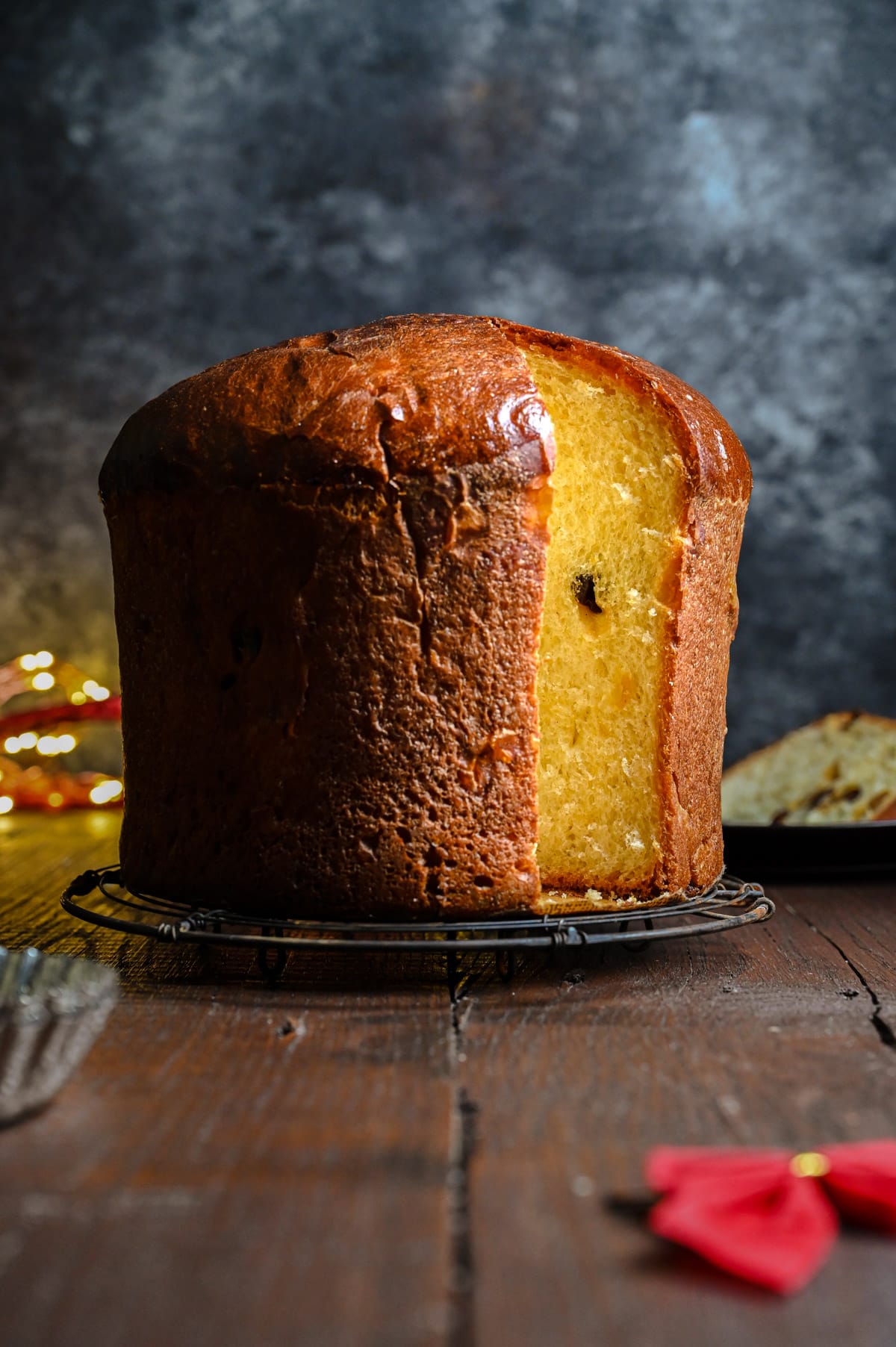
What’s Panettone and How to Eat It
Panettone is a traditional Italian, yeasted bread that is served around Christmas time. It’s baked in a tall mold, which creates its distinct shape.
Traditionally, panettone is filled with candied citrus and raisins, but there are so many variations. The bread is slightly sweet and rich from eggs and butter. It can be flavored with citrus zests or oils, vanilla and rum.
Typically, panettone is served for breakfast or an afternoon snack. You can pair it with espresso, coffee, tea or dessert wine. When it’s a little stale, it’s great dipped into coffee.
To make panettone more of a rich dessert, consider pairing it with whipped cream, whipped sweetened mascarpone, powdered sugar, gelato or ice cream.
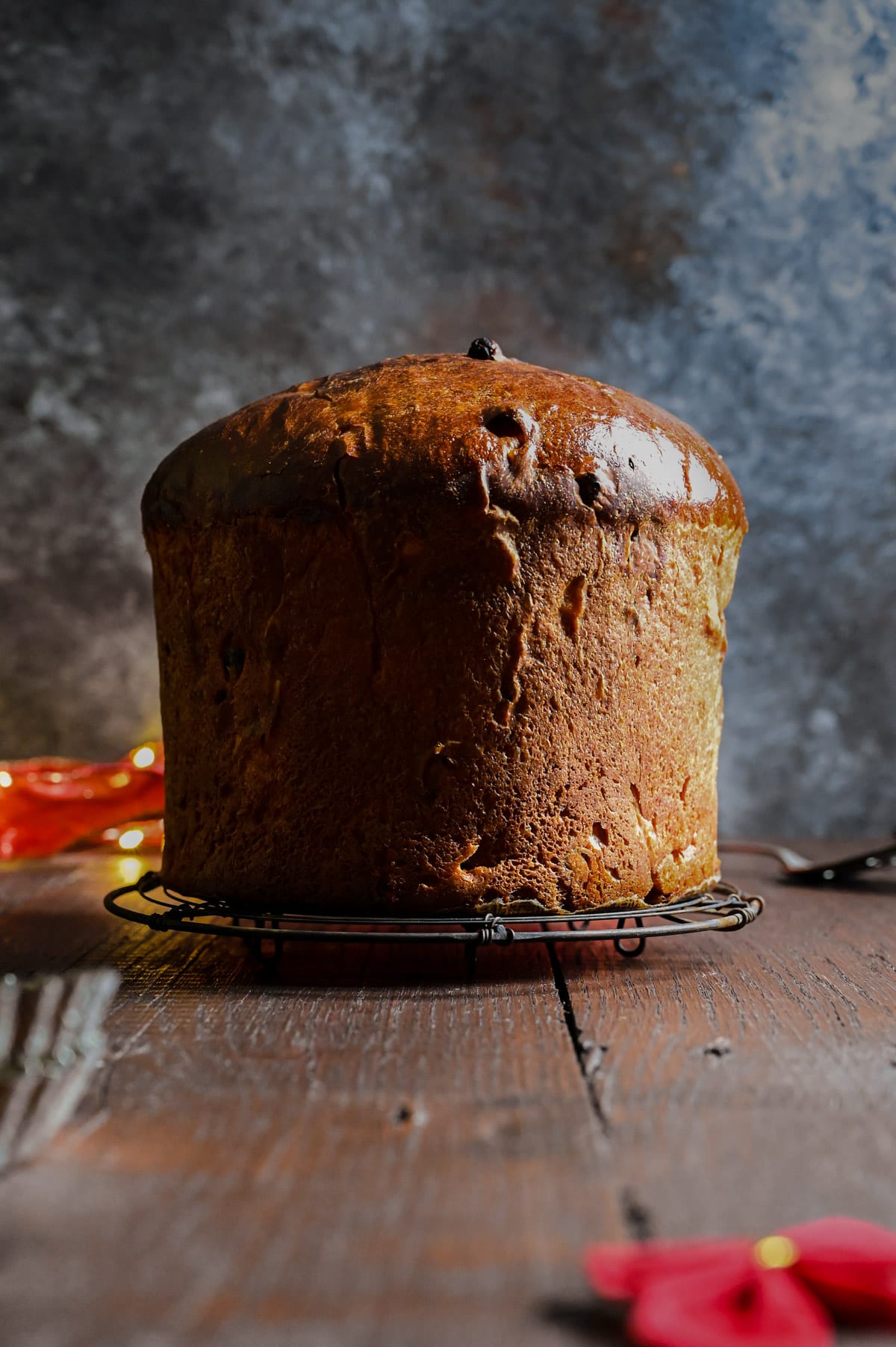
Ingredient Notes
Flour– In Italy, they usually use manitoba flour to make panettone. This is difficult to find in the states, and can be quite expensive to buy online. Good alternatives are 00 flour or bread flour. 00 refers to how fine the flour is ground, but there are different versions of 00 flour on the market. If your 00 flour says it’s good for bread and pizza, you have the correct type. You could use all-purpose flour, but there will not be as much gluten development. A higher protein flour contributes to a better, chewier texture.
Yeast- For panettone, you can use fresh yeast, instant yeast or active dry yeast. For one reason or another, I got better results with active dry yeast than instant yeast. Although you can make successful versions of the bread with any of these leaveners, they are not interchangeable. You need different amounts and different processes depending on which yeast you use.
Dried fruit- I choose to use golden and dark raisins, and candied orange peel. You can use dried currants, cranberries or cherries instead, depending on what you prefer.
Citrus zest- I keep this panettone simple, so I just use some fresh lemon and orange zest to flavor it. Bakeries or more serious bakers may use either citrus oil or purees of various citrus fruits cooked in a sugar syrup.
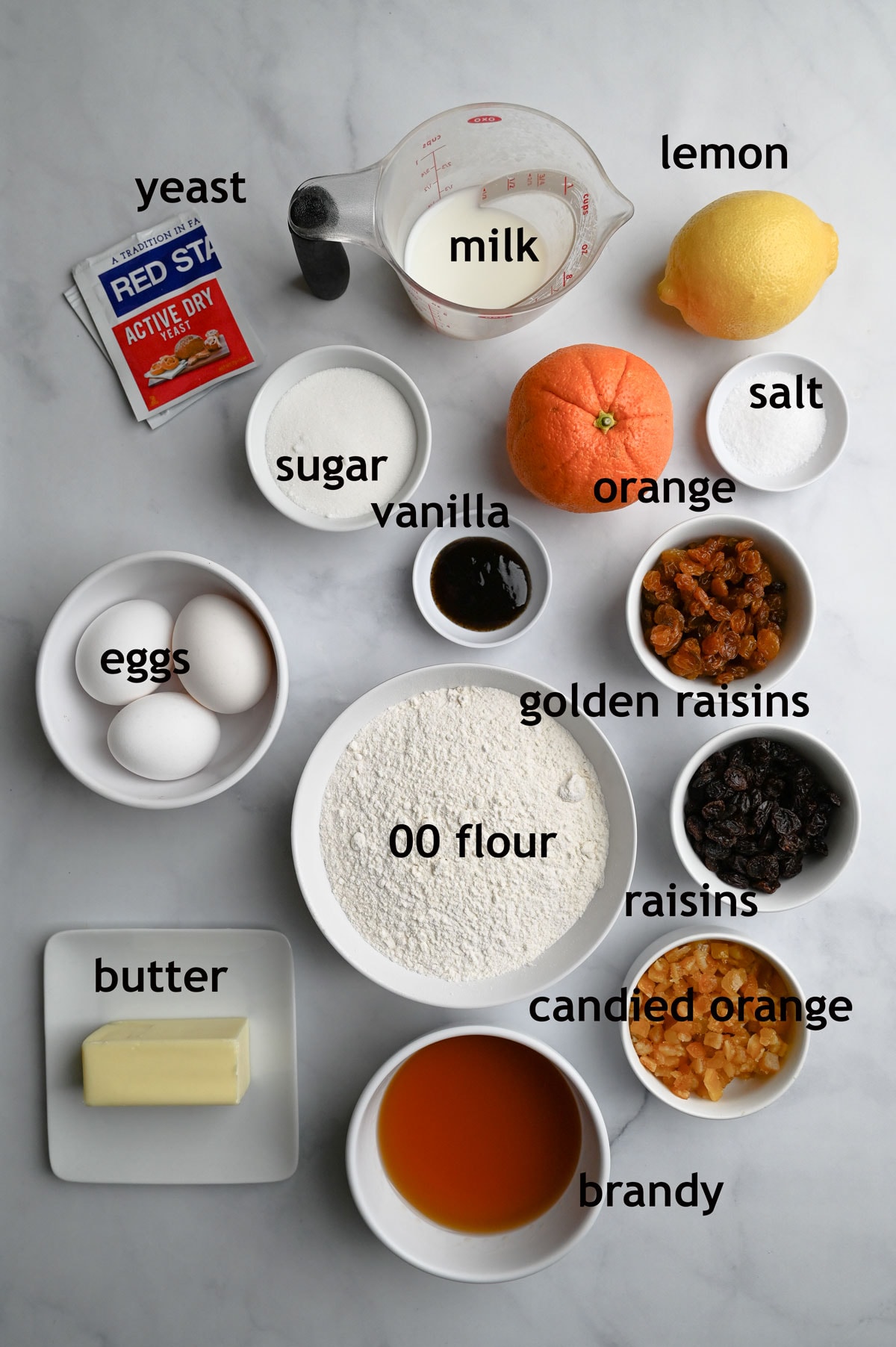
Recipe Steps
The authentic, bakery-style panettone can take several days to make and be a quite complicated. This version, is simplified and easy enough to make at home. But just a disclaimer, this recipe is probably not easy enough for novice bakers. It’s a good, happy medium between a very quick version and an all-out, complicated version.
I have tried many, quicker, simpler versions, and the end result was never great. If you try to rush the process of making panettone too much, it’s not worth it in my opinion. The bread should be fluffy and chewy with great flavor and texture.
The night before baking the bread, I make a quick biga or starter. Simply, proof a small amount of yeast and then mix it with some flour (1-2). Cover the bowl and allow it to ferment overnight (3). I also like to soak the raisins in some brandy overnight (4).
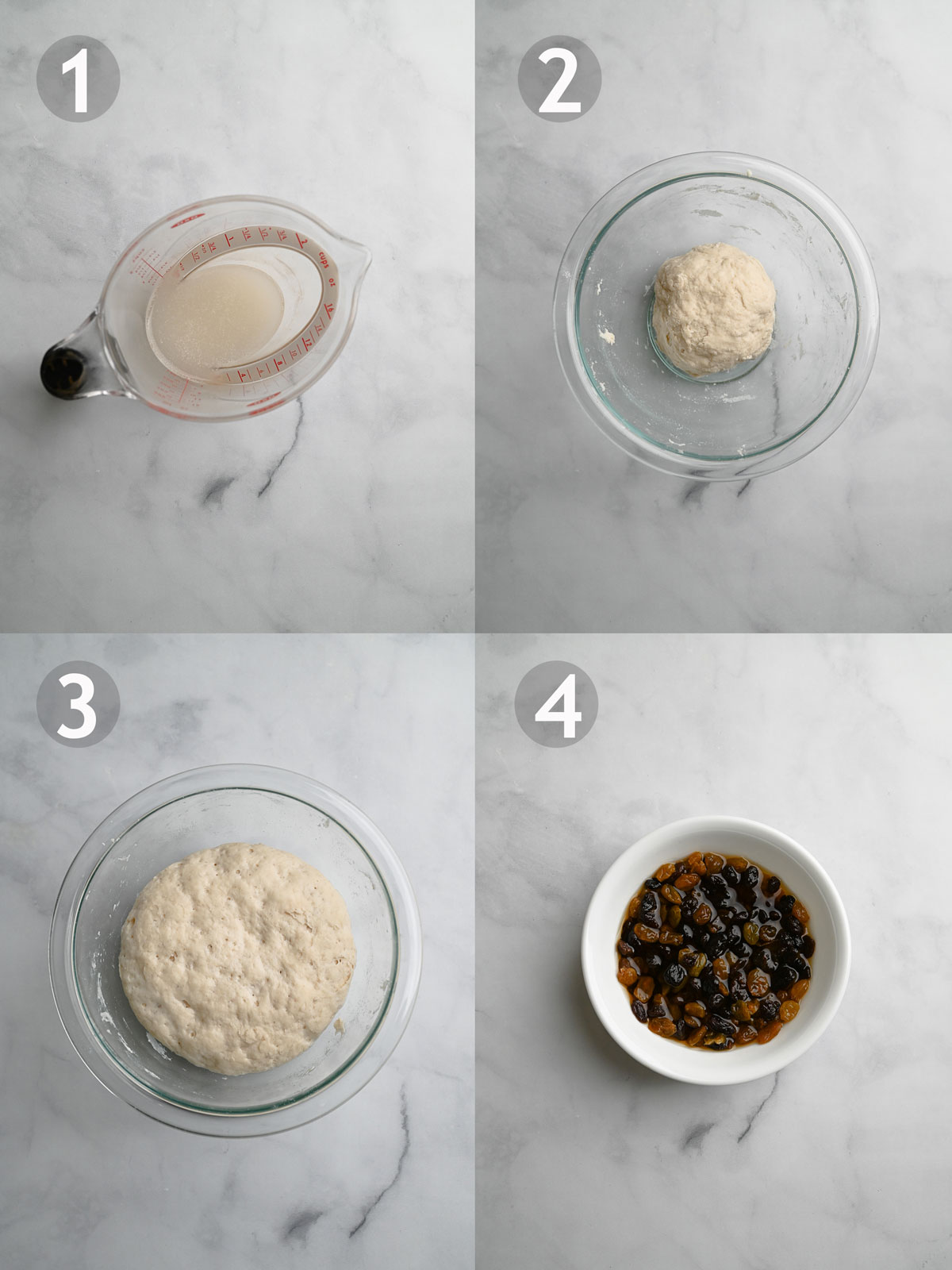
The next morning, drain the raisins (5). Then, proof the remainder of the yeast with warm milk and a small amount of sugar (6). Add the remaining flour, along with the eggs (7). Mix until smooth. Then add the biga, a small amount at a time, until fully incorporated (8).
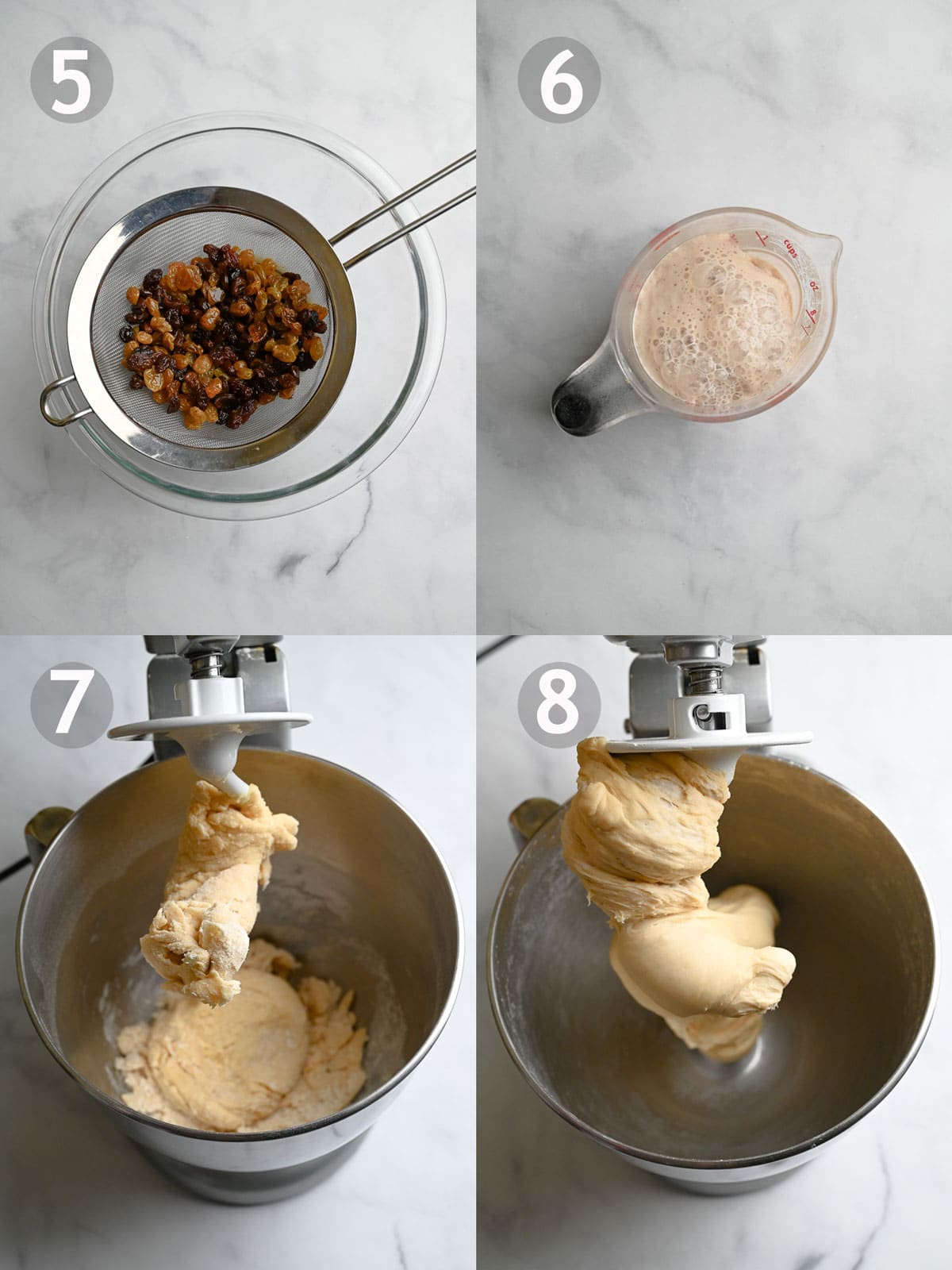
Next, transfer the dough to an oiled bowl (13). Cover and allow to rise in a warm place until doubled in size (14). Punch down the dough and add the dried fruit (15). Transfer the dough to a panettone mold (15).
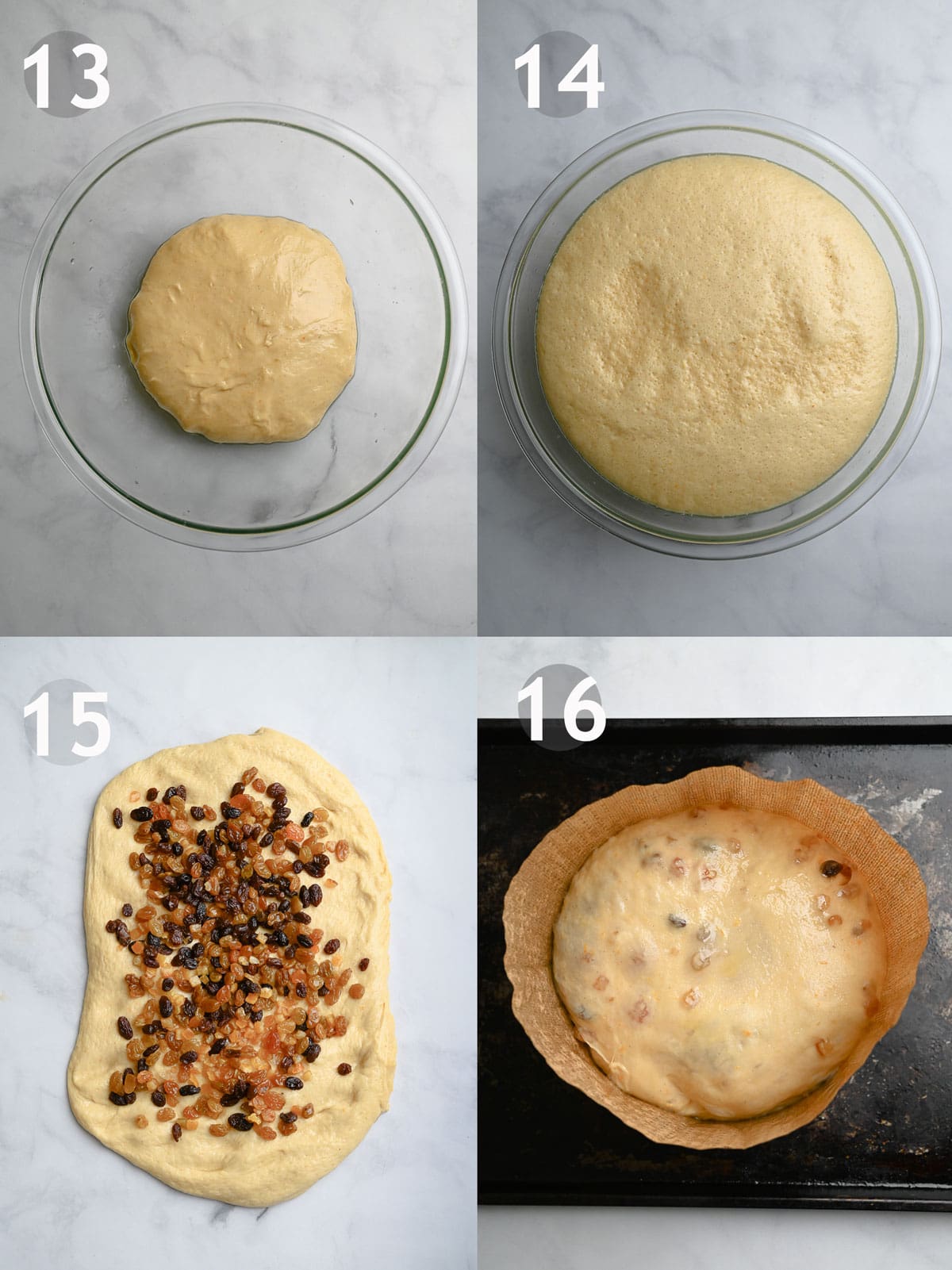
After the dough doubles in size again (17), carefully score the top of the dough with a large ‘x’, brush with egg wash and top with a pat of butter (18). Bake in a preheated oven until cooked through and then immediately hang upside down to cool completely (19). Allow to cool completely before serving (20).
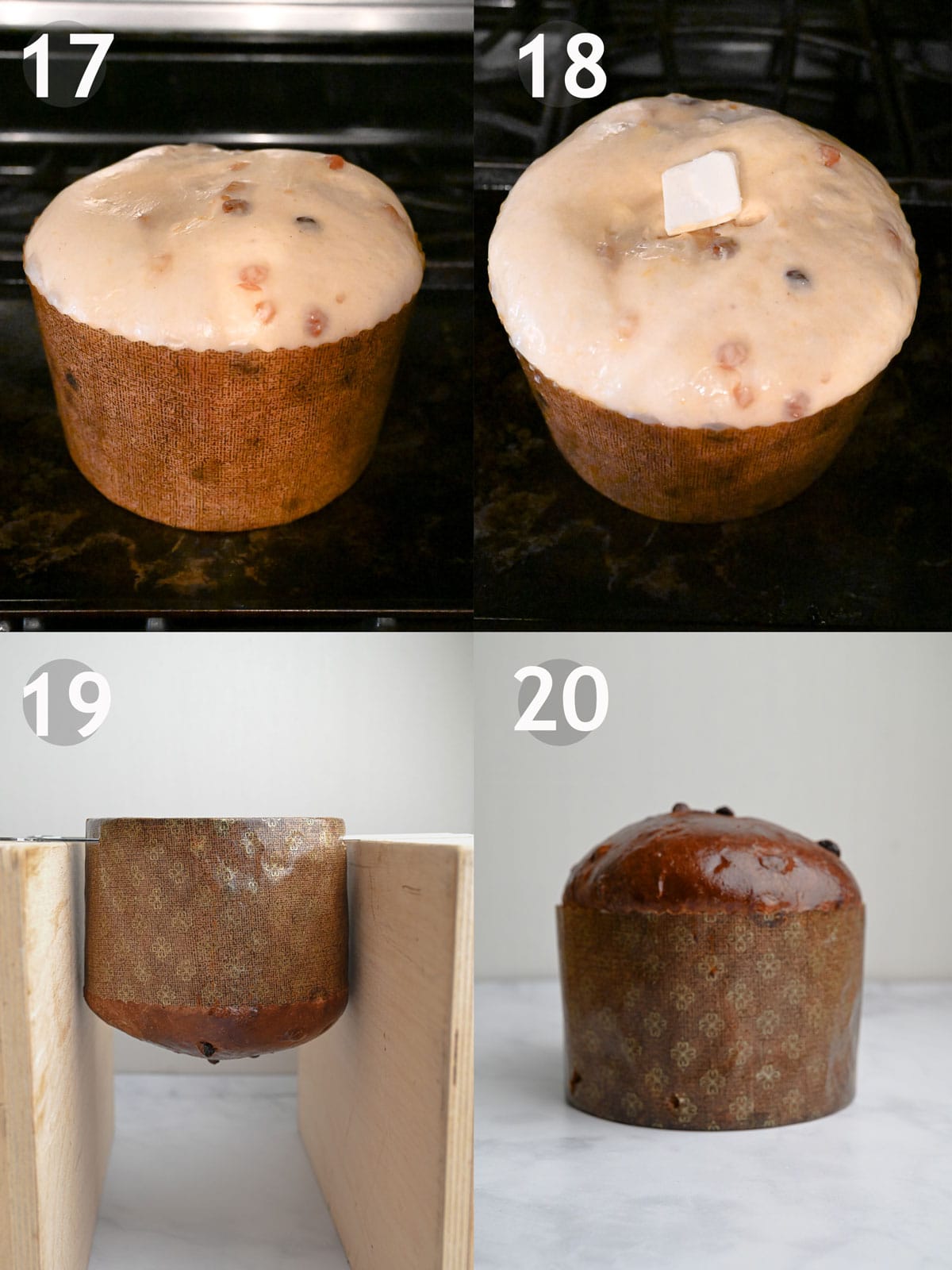
Recipe Tips and FAQs
- Try proofing the dough in the oven. The dough rises quite quickly at around 90F. To create a warm environment, heat the oven to the lowest setting. Use a thermometer (ideally an oven thermometer) to keep track of the temperature. After the oven reaches 100-110F degrees, place the dough in the oven to rise. Turn off the oven and shut the oven door at around 100F to trap in the heat. During the final rise, remove the bread from the oven before it’s done fully rising so you can preheat the oven. I sit the dough on top of the oven while it preheats to keep it warm.
- Try the window pane test. After the first rise when you add the butter and sugar to the dough, try the window pane test to check if the dough was kneaded enough. Stretch a piece of dough with both of your hands. If you can stretch it thin enough for light to pass through without the gluten strands breaking, you know it has been kneaded enough.
- Good gluten development is key. Several ingredients in the dough interfere with gluten development, including sugar, butter, vanilla, salt and the dried fruit. For the best result, I add these ingredients later in the bread-making process to allow for proper gluten development.
- Cool the bread upside down. Panettone is traditionally hung upside down to cool. This not only prevents the bread from sinking, but actually stretches the gluten strands further to create slightly larger air pockets, and a fluffier texture. You can poke wooden or metal skewers close through the bottom of the bread and hang it upside down on something sturdy. I used photography apple boxes, but you can use a large pot or two chairs, for example.
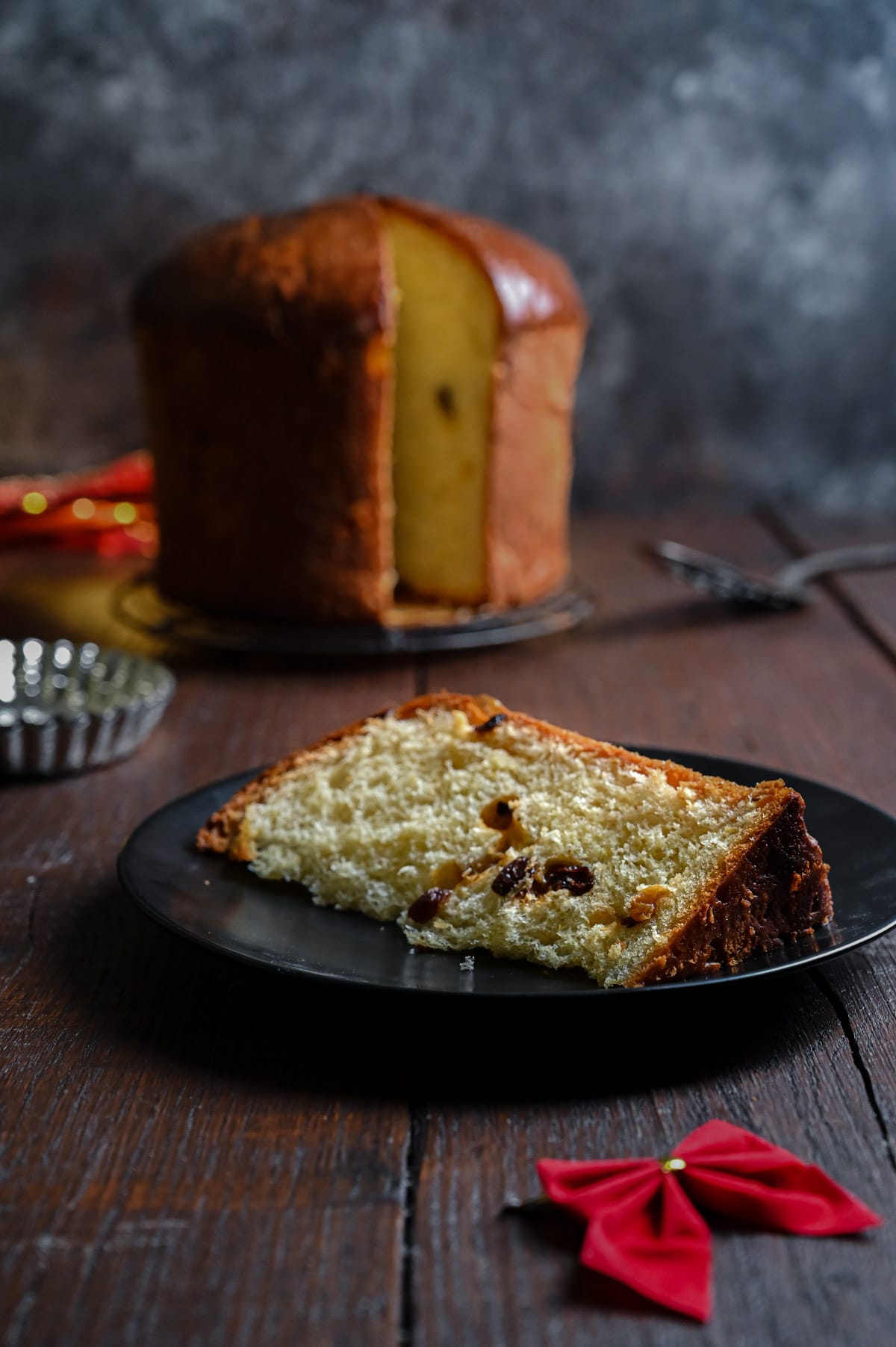
Homemade panettone last at least 2-3 days stored at room temperature. It gets noticeably dryer after 1 day, but is still great dipped in coffee or toasted.
Store panettone at room temperature wrapped in a plastic bag, foil or container of choice.
You can freeze panettone for up to 3 months. I wrap individual slices in plastic wrap and store them in a freezer bag. You can defrost the slices overnight in the fridge or in the oven.
You can toast leftover, stale panettone and serve it with butter and/or jam. You can also use it for French toast, bread pudding or a trifle.
Related Recipes
- Panettone Bread Pudding
- Sicilian Cannoli
- Nutella Cannoli
- Gingerbread Scones
- Cranberry Orange Scones
- Chewy Ginger Molasses Cookies
- Chocolate Peppermint Whoopie Pies
- Chocolate Crinkle Cookies
- Hazelnut Sandwich Cookies with Chocolate and Jam
- Peanut Butter Chocolate Chip Cookies
- Brown Butter Chocolate Chip Cookies
- Linzer Cookies with Strawberry Rose Jam
If you make this recipe, please post a comment and rating down below. If you want to be notified every time I post a new recipe, subscribe to my blog and give me a follow on my social accounts: instagram, pinterest, twitter, youtube. See you next time!
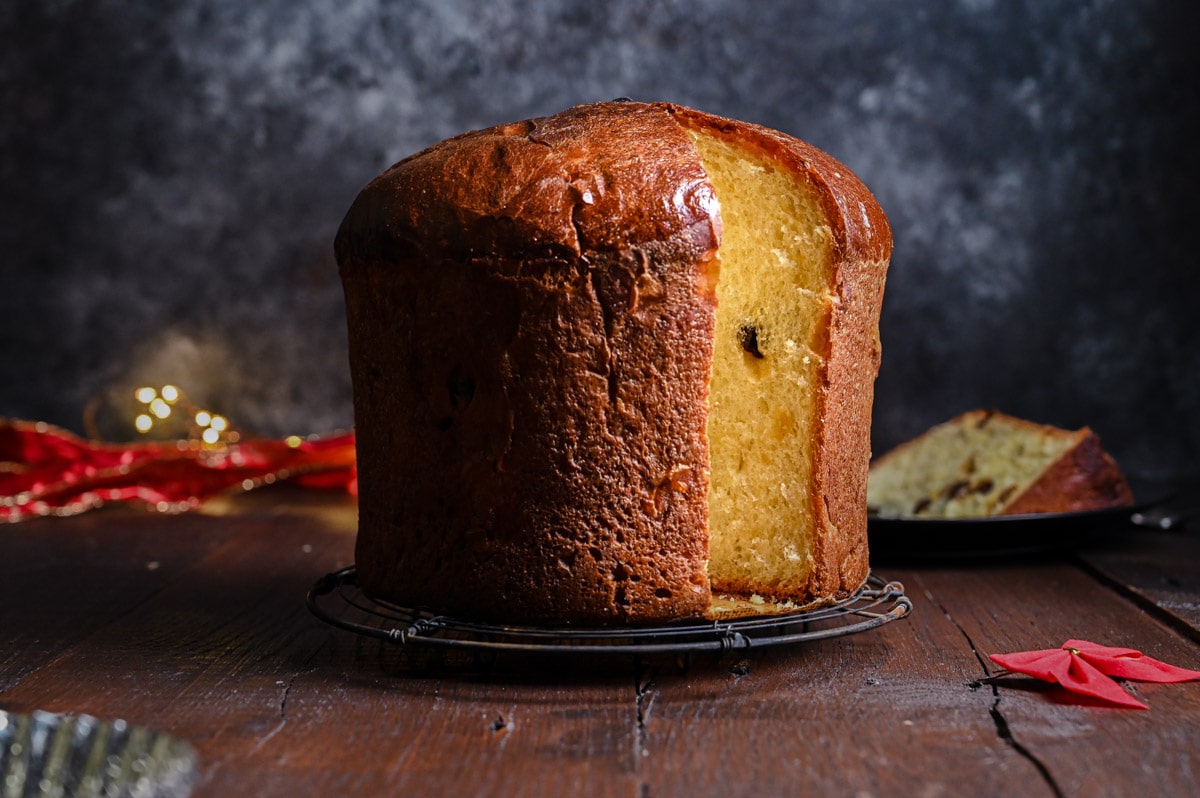
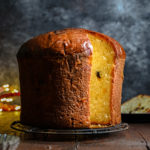
The Best Easy Panettone
- Total Time: 2 hours
- Yield: 1 loaf 1x
Description
Christmas just wouldn’t be the same without Panettone. After many trials, I think this recipe is the The Best Easy Panettone. It fluffy, delicious and simple enough to make a home.
Ingredients
-
3 cups strong ‘00’ flour or bread flour, divided
-
4 ⅛ teaspoons active dry yeast, divided
-
⅓ cup water
-
½ cup golden raisins
-
½ cup dark raisins
-
4oz brandy or dark rum (optional)
-
⅓ cup milk
-
3 large eggs
-
½ cup granulated sugar, divided
-
2 teaspoons kosher salt (1 ¼ tsp fine salt)
-
5 tablespoons unsalted butter, at room temperature
-
Zest of 1 large orange
-
Zest of 1 lemon
-
1 teaspoon vanilla bean paste or extract
-
¼ cup chopped, candied orange peel
-
1 egg, for egg wash
-
½ tablespoon of butter, for topping
Instructions
- Make biga (aka starter): Warm water to about 110-115F. Stir in ⅛ teaspoon of yeast and ¼ teaspoon of sugar. Proof for about 5 minutes, until foamy. Combine ¾ cup of flour with the yeast mixure to form a stiff dough. Cover with a plastic wrap or a damp cloth and sit at room temperature overnight. Allow to ferment for about 10-14 hours before preparing the dough.
- Soak raisins: Place both types of raisins into a bowl. Pour over brandy or rum (or water) and allow to plump up overnight while the biga ferments. If you have plump, chewy raisins to start and do not want to use alcohol, consider skipping this step. If you have dry, harder raisins or just want to add more flavor, do not skip this step. Drain raisins the next morning. Use the remaining liquor for another purpose, if desired.
- Bring ingredients to room temperature. The morning after you prepare the biga, place eggs and butter on the counter to come to room temperature. To hasten the process, place eggs in a bowl of warm water.
- Proof yeast: Warm milk to 110-115F. Stir in remaining 4 teaspoons of yeast and 1 teaspoon of sugar. Proof for about 5 minutes, until foamy.
- Make dough: In the bowl of a stand mixer fitted with a dough hook attachment, add the remaining 2 ¼ cups of flour, along with the eggs and yeast/milk mixture. Process over low to medium-low speed until smooth, about 3-5 minutes. Add biga, one, 1-inch chunk at a time until fully incorporated and smooth, about 7-10 minutes.
- Rise: Transfer dough to lightly oil boil. Cover with plastic wrap or a damp towel. Place in a warm place of the house and allow to rise until doubled in size, about 1-2 hours or so. To create a warm environment, I use my oven and an oven thermometer. I turn it to preheat on the lowest setting. Then, when it is about 90 to 100F or so, I place the bowl of dough in the oven, shut the oven off and close the door.
- Add sugar and butter: After the dough doubles in size, punch it down and transfer it back to the bowl of the standing mixer. Add the remaining sugar (slightly shy of a ½ cup), salt, citrus zest and vanilla. Mix over low to medium-low speed until smooth, just a few minutes. Add the softened butter, 1-2 teaspoons at a time until fully incorporated and no longer greasy looking, about 10-15 minutes. Meanwhile, rewarm the oven to 90-100F (if using for proofing). Transfer dough to lightly oil boil. Cover with plastic wrap or a damp towel. Place in a warm place to rise until doubled in size, about 1-2 hours. Make sure to shut off the oven if proofing inside of it.
- Add the fruit: Punch down the dough and transfer it to a lightly oiled surface. Flatten into a rectangle. Sprinkle over the drained raisins and candied citrus. Fold over the edges of the to entrap the fruit. Gently knead in the fruit, and shape into a ball. Make sure not too much fruit is on the outside of the dough, as it can burn while baking. Rewarm the oven to 90-100F if proofing there, making sure to shut it off before adding the bread. Transfer to a large panettone mold (4.8×6.75in). Cover and place in the oven to proof. After 30-60 minutes, when the dough is roughly 1.5 times the original volume, remove from oven and place on the stove top. Preheat oven to 400F.
- Bake: After dough rises just above the panettone mold or doubles in size, beat together an egg with 1 tablespoon of water. Brush top of bread. Score a large ‘x’ on the top of the dough with a razor blade or sharp knife. Place pat of butter in the center of the cross. Bake for 15 minutes at 400F. Reduce heat to 350F (do not open oven) and continue to bake for 30-45 minutes, or until the center of the bread registers between 190-195F, and a tester comes out clean.
- Hang upside down: Right after the bread comes out of the oven, poke two skewers through the bread close to each edge and about ½ inch from the bottom. Hang it upside down on something sturdy. I used photography apple boxes, but you can use a large pot or two chairs, for example. Allow to cool for about 2 hours or until room temperature. Take down and remove skewers. Cool completely before serving. Enjoy.
Notes
Substitute dried fruit with dried cranberries, currants, apricots and/or cherries, as desired.
I bought my molds on Amazon. You can also use parchment paper and a springform pan or other round to create a makeshift mold like this.
Store bread in an airtight container, in a plastic bag or wrapped in foil for up to 2-3 days at room temperature.
Freeze for up to 3 months. I like to wrap individual slices in plastic wrap and store them in a freezer bag. Defrost overnight in the fridge or in the oven.
Use leftover panettone for toast, French toast, bread pudding or trifle.
- Prep Time: 1 hour
- Cook Time: 1 hour
- Category: Bread
- Method: Bake
- Cuisine: Italian
Nutrition
- Serving Size: 1/12 of bread
- Calories: 282
- Sugar: 19g
- Sodium: 270mg
- Fat: 7g
- Saturated Fat: 4g
- Unsaturated Fat: 3g
- Trans Fat: 0g
- Carbohydrates: 47g
- Fiber: 2g
- Protein: 7g
- Cholesterol: 60mg
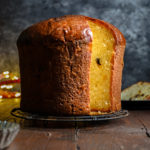
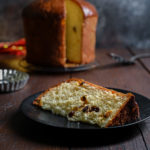
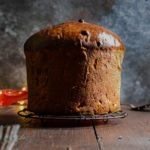
My favorite holiday treat! Thank you for sharing this recipe.
Thank you 🙂
Thanks Liz! The texture is different, but I found it tasty and a good quick fix. I’m going to try for the traditional version next year and probably make baking powder one again too.
I’ve never made panettone with baking powder. This is quite interesting. Thanks for sharing. I have bookmarked to try it for sure!
Wow! what a beautiful panettone! You have a great blog Sabrina! So glad you visited my blog. thank you for the follow!
Thank you!! I really enjoyed your blog too 🙂
This looks lovely. I see I am not the only panettone procrastinator. Next Christmas it will be panettone and stollen for sure 🙂
Haha, sounds good! I need to try to make stollen, too :). Thank you and Merry Christmas!
Merry Christmas Sabrina! love this panettone, bonus points on being quick!
Thank you so much! Merry Christmas, Manali!
I remember having this when I lived in London without knowing it’s actually a traditional Italian bread people eat during X-mas back then. I love how festive and rustic it looks and tastes. Thanks for the recipe Sabrina, and Merry Christmas!
Thanks so, Jin! I’m glad to hear you’ve tried panettone in the past. Merry Christmas!
Great to know the no-yeast version is so good. Looks wonderful! 🙂
Thanks so much, Ronit!